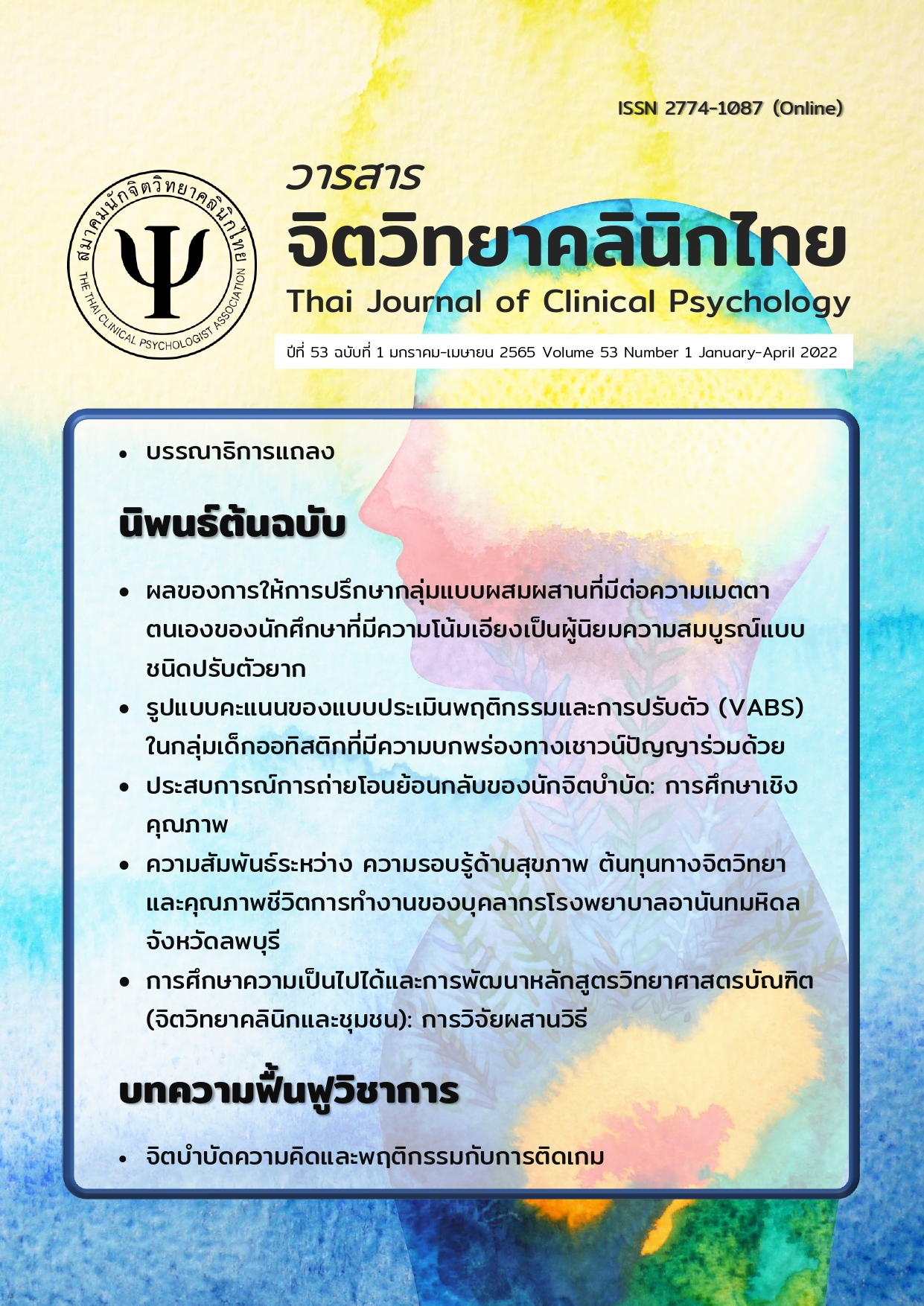รูปแบบคะแนนของแบบประเมินพฤติกรรมการปรับตัว (VABS) ในกลุ่มเด็กออทิสติกที่มีภาวะบกพร่องทางเชาวน์ปัญญาร่วมด้วย
Main Article Content
บทคัดย่อ
วัตถุประสงค์ ศึกษารูปแบบคะแนนของแบบประเมินพฤติกรรมและการปรับตัว (Vineland Adaptive Behavior Scales: VABS) และความสัมพันธ์ระหว่างคะแนนพฤติกรรมการปรับตัวโดยรวม (adaptive behavior composite) กับคะแนนในแต่ละด้านของเด็กออทิสติกที่มีความบกพร่องทางเชาวน์ปัญญา วัสดุและวิธีการ การศึกษาแบบเก็บข้อมูลย้อนหลังที่กลุ่มงานจิตวิทยา สถาบันราชานุกูล กลุ่มตัวอย่างคือเด็กออทิสติก อายุ 6-12 ปีที่มีความบกพร่องทางเชาวน์ปัญญาระดับน้อยหรือปานกลาง วิเคราะห์ข้อมูลด้วย Mann-Whitney U test และค่าสัมประสิทธิ์สหสัมพันธ์ของเพียร์สัน ผล กลุ่มตัวอย่างเพศชาย 92 คนและเพศหญิง 17 คน อายุเฉลี่ย 7.75 ปี มีคะแนนพฤติกรรมการปรับตัวโดยรวมเทียบเท่าอายุ 3.29 ปี พบความสามารถด้านการใช้ชีวิตประจำวัน เทียบเท่าอายุ 3.59 ปี ด้านการสื่อสารเทียบเท่าอายุ 2.73 ปี และด้านการเข้าสังคมเทียบเท่าอายุ 2.63 ปี รูปแบบคะแนนของแบบประเมินพฤติกรรมและการปรับตัวแตกต่างกันตามระดับความบกพร่องทางเชาวน์ปัญญาอย่างมีนัยสำคัญทางสถิติที่ระดับ 0.01 คะแนนพฤติกรรมการปรับตัวโดยรวมมีความสัมพันธ์แบบแปรผันตามกับด้านการสื่อสาร (r=0.835) ด้านการใช้ชีวิตประจำวัน (r=0.801) และด้านการเข้าสังคม (r=0.745) ตามลำดับ ความสัมพันธ์ภายในของทุกด้านหลักและด้านย่อย มีความสัมพันธ์แบบแปรผันตาม (r> 0.5) อย่างมีนัยสำคัญทางสถิติที่ระดับ 0.05 สรุป แบบประเมินพฤติกรรมและการปรับตัวในเด็กออทิสติกที่มีความบกพร่องทางเชาวน์ปัญญา มีคะแนนพฤติกรรมการปรับตัวโดยรวมน้อยกว่าอายุจริงและมีทักษะด้านการใช้ชีวิตประจำวันสูงกว่าด้านอื่นๆความสามารถด้านการสื่อสารมีความสัมพันธ์แบบแปรผันตามในระดับสูงกับพฤติกรรมการปรับตัวโดยรวม
Article Details

This work is licensed under a Creative Commons Attribution-NonCommercial-NoDerivatives 4.0 International License.
เรื่องที่ลงตีพิมพ์ในวารสารจิตวิทยาคลินิกแล้วถือเป็นลิขสิทธิ์การเผยแพร่โดยวารสารจิตวิทยาคลินิกแต่เพียงผู้เดียว การตีพิมพ์หรือเผยแพร่ซ้ำในที่อื่นต้องได้รับอนุญาตจากกองบรรณาธิการวารสารฯ
References
American Psychiatric Association. (2010). Diagnostic and Statistical Manual of Mental Disorders, Fourth Edition (DSM-IV) (4th ed.). American Psychiatric Pub.
American Psychiatric Association. (2013). Diagnostic and statistical manual of mental disorders (DSM-5®). American Psychiatric Pub.
Baron Cohen, S., Leslie, A. M., & Frith, U. (1985). Does the autistic child have a “theory of mind” Cognition, 21, 103–128.
Black, D. O., Wallace, G. L., Sokoloff, J. L., & Kenworthy, L. (2009). Brief report: IQ split predicts social symptoms and communication abilities in high-functioning children with autism spectrum disorders. Journal of Autism and Developmental Disorders, 39(11), 1613-1619. https://doi.org/10.1007/s10803-009-0795-3
Burack, J. A., & Volkmar, F. R. (1992). Development of low- and high-functioning autistic children. Journal of Child Psychology and Psychiatry, 33(3), 607-616. https://doi.org/10.1111/j.1469-7610.1992.tb00894.x
Carter, A. S., Dawson, G., Fombonne, E., Loveland, K., Mesibov, G., Schopler, E., Lord, C., Wang, J. J., Sparrow, S. S., & Volkmar, F. R. (1998, August 28). The Vineland Adaptive Behavior Scales: supplementary norms for individuals with autism. Journal of Autism and Developmental Disorders, 28, 287–302. https://doi.org/10.1023/a:1026056518470
Centers for Disease Control and Prevention. (2012, March 30). Prevalence of autism spectrum disorders--Autism and Developmental Disabilities Monitoring Network. PubMed. https://pubmed.ncbi.nlm.nih.gov/22456193/
Di Nuovo, S. F., & Buono, S. (2007). Psychiatric syndromes comorbid with mental retardation: Differences in cognitive and adaptive skills. Journal of Psychiatric Research, 41(9), 795-800. https://doi.org/10.1016/j.jpsychires.2006.02.011
Eccles, J. S. (1999). The development of children ages 6 to 14. The Future of Children, 9(2), 30. https://doi.org/10.2307/1602703
Gabriels, R. L., Ivers, B. J., Hill, D. E., Agnew, J. A., & McNeill, J. (2007). Stability of adaptive behaviors in middle-school children with autism spectrum disorders. Research in Autism Spectrum Disorders, 1(4), 291-303. https://doi.org/10.1016/j.rasd.2006.11.004
Kraijer, D. (2000, February). Review of adaptive behavior studies in mentally retarded persons with autism/Pervasive developmental disorder. Journal of Autism and Developmental Disorders, 30, 39–47.https://doi.org/10.1023/A:1005460027636
Loveland, K. A., & Kelley, M. L. (1991, July). Development of adaptive behavior in preschoolers with autism or Down syndrome. PubMed. https://pubmed.ncbi.nlm.nih.gov/1831619/
Manager Online. (2017, July 23). Rengvijai GENE cause of autism It is estimated that 3 hundred thousand Thai children will be diagnosed. Manager Online. https://mgronline.com/qol/detail/9600000074845
Mouga, S., Almeida, J., Café, C., Duque, F., & Oliveira, G. (2014). Adaptive profiles in autism and other neurodevelopmental disorders. Journal of Autism and Developmental Disorders, 45(4), 1001-1012.
https://doi.org/10.1007/s10803-014-2256-x
Ozonoff, S. & Jensen, J. (1999). Brief Report: Specific executive function profiles in three neurodevelopmental disorders. Journal of Autism and Developmental Disorders, 29, 171–177.
Perry, A., Flanagan, H. E., Dunn Geier, J., & Freeman, N. L. (2009). Brief report: The vineland adaptive behavior scales in young children with autism spectrum disorders at different cognitive levels. Journal of Autism and Developmental Disorders, 39(7), 1066-1078. https://doi.org/10.1007/s10803-009-0704-9
Rajanukul Institute, Yuwaprasart Waithayopathum Child and Adolescent Psychiatric Hospital, Child and Adolescent Mental Health Rajanagarindra Institute. (2011). Psychological Testing Manual for Children (Full Version) (1st ed.). Beyond Publishing CO., LTD.
Sparrow, S., Balla, D., & Cicchetti, D. (1984). Vineland Adaptative Behaviour Scales: Interview edition, survey form. American Guidance Service.

